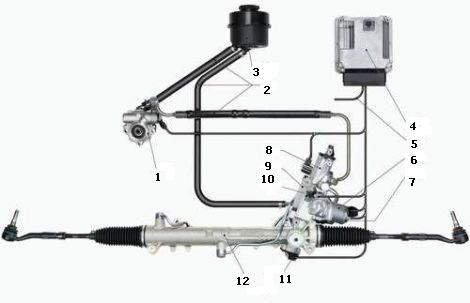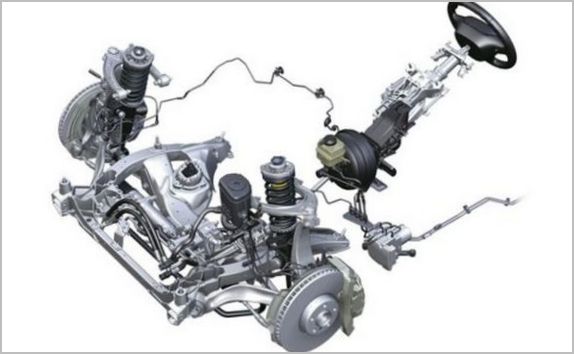
How AFS - Active Steering Systems work
Content
Automation, armed with the algorithms of the world's best engineers and testers, has long known how to drive cars better than the vast majority of their drivers. But people are not yet ready to fully trust it, innovations are being introduced gradually, while maintaining the possibilities of manual control. Approximately according to this principle, the AFS active steering drive system is built.

System operation algorithm
The main feature of AFS is the variable steering gear ratio. To organize the dependence of this parameter on speed, and even more so on some other influencing factors, turned out to be not so simple as it might seem to automation specialists. The rigid mechanical drive from the steering wheel to the steered wheels had to be preserved; the automotive world would not soon move on to the full implementation of the control system purely by electric wires. Therefore, Bosch acquired a patent from an American inventor, after which, together with BMW, an original steering system was developed, called AFS - Active Front Steering. Why exactly “Front” - there are active type systems that also involve the rear wheels.
The principle is simple, like all ingenious. Conventional power steering was used. But a planetary gear was built into the section of the steering column shaft. Its gear ratio in dynamic mode will depend on the speed and direction of rotation of the external gear with internal gearing (crown). The driven shaft, as it were, catches up with or lags behind the leading one. And this is controlled by an electric motor, which through a notch on the outer side of the gear with its worm drive causes it to rotate. With a sufficiently high speed and torque.

New qualities that AFS has acquired
For those who got behind the wheel of the new BMWs equipped with AFS, the first sensations bordered on fright. The car unexpectedly briskly reacted to taxiing, forcing to forget the habit of "winding" on the steering wheel in parking modes and maneuvering at low speeds. The car was rearranged on the road like a racing kart, and small turns of the steering wheel, while maintaining lightness, forced us to take a fresh look at the processes of turns in a cramped space. Fears that a car with such reactions would be impossible to drive at high speeds were quickly dispelled. When driving at a pace of 150-200 km / h, the car acquired an unexpected solidity and smoothness, keeping a stable state well and not trying to break into a slip. The following conclusions could be drawn:
- the gear ratio of the steering gear, when changed by about half with an increase in speed, provided convenient and safe control in all modes;
- in extreme conditions, on the verge of slipping, the car showed unexpected stability, which was clearly not due only to the variable gear ratio of the steering gear;
- the understeer was always kept at an optimally balanced level, the car did not tend to skid the rear axle or to skid the front axle;
- little depended on the skill of the driver, the help of the car was clearly noticeable;
- even if the car was intentionally skidding by deliberately aggressive actions of an experienced driver, it was easy to drive in it, and the car itself got out of it as soon as the provocations stopped, and absolutely accurately and without counter-skids.
Now many stabilization systems are capable of something similar, but it was only the beginning of the century, and only steering was involved, without braking and traction vector torques.
Due to what the effect of active taxiing was formed
The electronic control unit collects information from a set of sensors that monitor the steering wheel, the direction of the car, angular accelerations and many other parameters. In accordance with the fixed mode, it does not just change the gear ratio, as it is organized depending on the speed, but organizes active steering, interfering with the actions of the driver. This is the first step towards autonomous control.
In this case, the connection between the steering wheel and the wheels remains unchanged. When the electronics are turned off, artificially or due to malfunctions, the shaft of the electric motor that rotates the planetary mechanism stops and stops. Management turns into a conventional rack and pinion mechanism with an amplifier. No steer by wire, that is, control by wire. Only planetary gear with controlled ring gear.
At high speeds, the system made it possible to very accurately and smoothly rearrange the car from lane to lane. The same effect was partially realized as when steering the rear axle - its wheels more accurately followed the front ones, without provoking oversteer and skidding. This was achieved by automatically changing the angle of rotation on the controlled axle.
Of course, the system turned out to be more complex than traditional steering, but not by much. A planetary gearbox and an additional electric drive slightly increase the cost, and all functions were assigned to a computer and software. This made it possible to implement the system on all series of BMW cars, from the first to the seventh. The mechatronics unit is compact, looks like a conventional electric power steering, gives the driver the same feeling of a car, provides feedback and becomes intuitive after quickly getting used to the changing sharpness of the steering wheel.
The reliability of the system is not much different from the traditional mechanism. There is only a slightly more intense wear of the rack and pinion due to the increased engagement force. But this is a small price to pay for a completely new quality of the car in handling at any speed.
